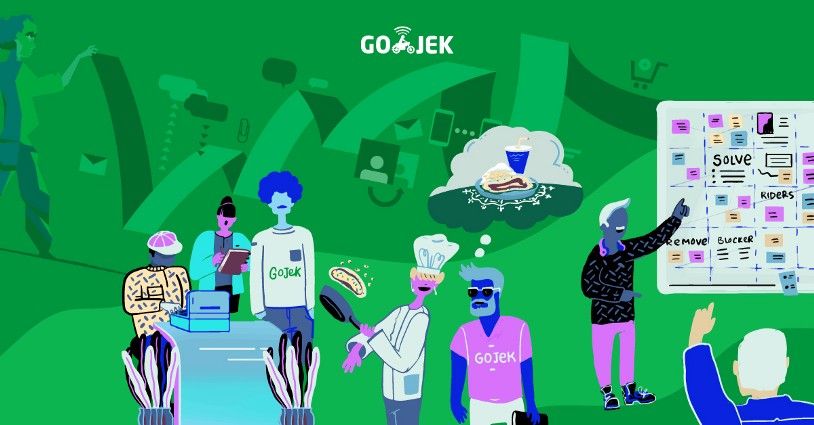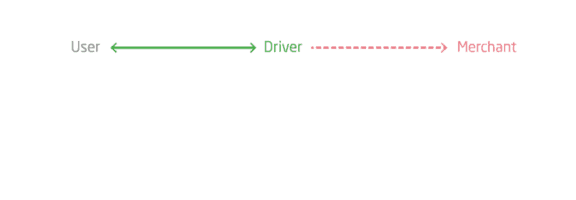What’s Cooking? Diving into kitchens for - GoBiz
How much user knowledge does it really take to build and raise a new product?

By Sakti Nuzan
One towering challenge we had with GoFood, the go-to solution for hungry, lazy tummies across Indonesia, was streamlining our service.
We’re the largest single-market food delivery app and among the largest food tech startups in the world. Within two years, GoFood grew so fast it became essential for us to ensure excellent service to all stakeholders. This included not only customers, but also partner drivers and food merchants.
This post details the groundwork done to build GoBiz, our merchant-facing app.
The Challenge
GoBiz’s inception phase was a delivery management app for GoFood restaurant partners, originally called GoResto. The main objective for this was to curb manual tasks and help restaurateurs manage their services for GoFood users.
In short, it gave merchants a platform to ramp up profits. Sounds easy? Not when you’re witnessing 10x growth week-over-week in both transactions and user base. From a product development perspective, it was a huge task to embark on.
GoFood boasts over 300,000 merchants on its platform. This ranges from one-man food stalls; many of which are legendary traditional joints, to full-fledged restaurants with complex systems. So how do we design a service for one new node in our ecosystem, which we have very limited knowledge of?

Research: the fodder for design
I believe the notion that ‘startups should fail more to learn’ is getting obsolete. There are enough templates to learn from, not to mention that it’s super costly to fail. A good portion of this holds true to Gojek: our aim is to build product solutions not just quickly, but correctly.
Research is one important pillar to fulfil this goal. To unearth a framework for designing the product, we took a deep dive into the lives of our partnering restaurants. Our secret mission was also to make user empathy widespread — to the point of it being a norm across the organisation.
I often get two staple responses upon revealing my designation as a Product Researcher: either puzzled faces asking if it’s some sort of R&D function (usually from folks outside of tech), or confirmatory shouts of “UX research!” (from those within). Both are not wrong. At Gojek, tight collaboration is a value we admire. The goal of research is to provide outside-in understandings of our users in a method-neutral attitude. That way, we know we’re not settling too easily on getting the answers to our wicked problems.
Segmenting merchants better, and co-designing
We approached the problem by collating hypotheses derived from GoFood data with real-life insights. From here, a framework was formed to rethink the way we see our vast list of merchants.
If we were only to speak business metrics, bucketing merchants based on scale may be sufficient. But to deliver a product that improved the daily routines of all potential users — owners, managers, and staff— we had to dig deeper.
So we looked beyond. Our team interviewed and shadowed cooks, manned cashier desks, and made notes inside kitchens.
The spirit of it all was to be as tech agnostic as possible.
We had to find a middle ground that married our product goals and those of the shops that would benefit from adopting our technology. From here, we built a matrix of ‘archetypes’ that bucketed the businesses’ complexity of management and use of technology. Mapping archetypes, we found, was paramount to learn what it takes to get a typically tech-averse generation to embrace GoBiz.

How can this journey impact product development? To illustrate, let’s imagine if GoBiz benchmarked its development only from the immediate knowledge of enterprise merchants. This meant we would only learn from how Point of Sales (POS) machines are understood by trained cashiers and waiters. In reality, we also deal with traditional hawkers, or stalls manned by one individual. Many of these mom-and-pop shops are runaway favourites, with hundreds of orders every day.
Technology should impact the broader good — not merely the ones who are privileged to be onboarded. This was critical if we wanted to truly enable all to thrive.
This reframed the ways we think of our design. After three weeks of fieldwork, we stepped back and asked ourselves: What are the critical touchpoints we need to address if we want widespread and easy adoption of GoBiz?

Additionally, we saw that envisioning a service with only researchers inside a vacuum would never be meaningful and efficient. So we invited our Product Managers and Tech Leads to co-design along with business owners and their staff. Even though there is some truth in the saying ‘people don’t know what they want’, we were giving room for unseen opportunities to arise.
In short: we put on our users’ shoes to see our design with a fresh pair of eyes.

Solving wicked problems collectively
Our work didn’t stop at framing user journeys. The idea of purposeful communication, one of Gojek's upheld values, requires us to deliver research reports and campaign for actions necessary in moving forward.
Moulding strategies from qualitative inspirations is an elusive target. It takes time, involves a lot of uncertainties, and often requires extrapolations — intuitive ‘leaps of faith’. Our way of countering this was by having ruthless structure and quantitative backups to our arguments in the synthesis process. For example, to make sense to the spectrum of tech savviness we built to classify merchants, we drilled the field team to exhaust mutually exclusive characteristics for different groups. Later on, we compared this with our internal data to find measures that correlate to it.
Finally, we came back to our meeting room and had stakeholders across the business to convene in problem-solving sessions. Here, we learned the importance of ensuring everyone has access to the research. This involved stretching the invite not only to the product peeps, but also our business, marketing, ops, and sales teams 🤝
We embarked on a journey to identify archetypes and develop a product, but higher objectives were also served. Now, different functions had broader and clearer views of our ecosystem, and could pick up the baton for their own work.

After two months of research and data collection, the second version of our MVP was achieved. This iteration implemented functionalities that answer the needs gathered from the research. However, the next ambition is for GoBiz to not only cater to restaurants and their food delivery service, but much more. (Hint: think non-food businesses!)
How exactly did we do feature and design priorities from the foundational insights? We’ll walk you through how the hours spent with merchants helped us design impactful interactions in a future post.
We are always learning, whether it is new technologies, or understanding our users better. We’re growing too, into new markets like Vietnam, Singapore and Thailand. Everywhere we go, there is always something new to learn about how we can build better, more beautiful products 🙏. Check out gojek.jobs and join us on our journey.